Personalizing Your Wedding Ceremony Venue
The wedding ceremonies I perform are almost exclusively at non-traditional wedding venues – ie not in a church. One disadvantage to these venues can be the lack of a focal point for the ceremony – there is no altar or stage to draw everyone’s eye. Using an arch or tall floral arrangements can solve this problem. They also provide an opportunity to express your personal style.
Maybe sculpted topiary is perfect for you, or maybe wild curly willow branches speak to you. Floral arrangements on an outdoor arch can also express your personal style, and allow you to coordinate with other wedding floral as one couple did with this lovely asymmetrical floral accent on a metal arch.

If your ceremony is being held indoors – in a ballroom, barn or museum, for example, the same situation exists. You want some way to bring people’s attention to the front of the ceremony space where the action will be, and you may also want to provide a more personal and festive touch to a basically blank slate. Draping and lighting can help create the ceremony focal point, but bringing nature indoors can be accomplished, too, as two couples demonstrated in very different ways at ceremonies this year.
The first couple opted for a more formal, elegant approach with a custom built white wooden arch that was topped with an extravagant floral display. This ceremony was planned for outdoors, but when weather forced us indoors, the floral arch helped bring the outdoors inside and created a beautiful focal point in the room.

And finally, one couple took a more rustic, natural approach to ceremony decor with a massed grouping of cut tree trunks, greenery and candles. This warm and welcoming display greeted guests at the back of the ceremony space, and was carried through with greenery on the aisle chairs and tall urns that combined natural branches and cut flowers marking the front of the ceremony space.

Creating a special space that reflects your style is a great way to welcome your guests to your wedding ceremony, and can provide an indication of the style and tone of the entire wedding day. This is a great place to get creative, whether your budget is large or small, and let your personality shine.
